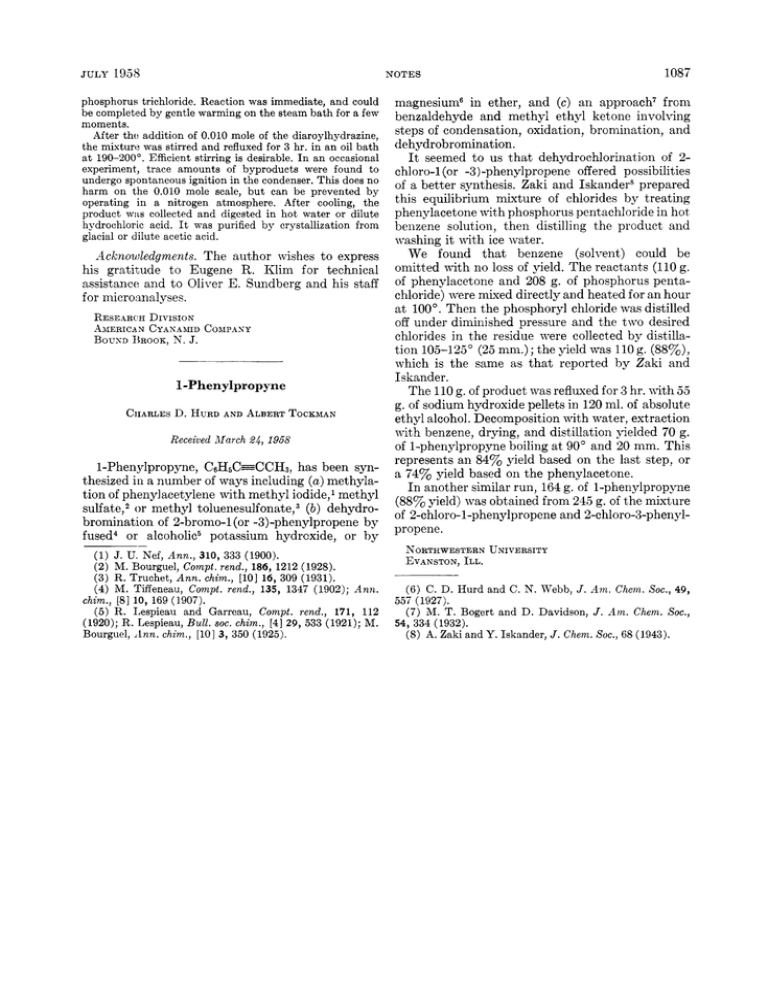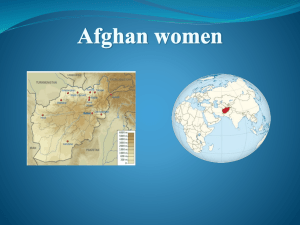1087 Aclcizowledgments. The author wishes to express his gratitude
advertisement

JULY 1958 NOTES phosphorus trichloride. Reaction was immediate, and could be completed by gentle warming on the steam bath for a few moments. After thr: addition of 0.010 mole of the diaroylhydrazine, the mixture was stirred and refluxed for 3 hr. in an oil bath a t 190-200". Efficient stirring is desirable. I n an occasional experiment, trace amounts of byproducts were found to undergo spontaneous ignition in the condenser. This does no harm on the 0.010 mole scale, but can be prevented by operating in a nitrogen atmosphere. After cooling, the product w:ts collected and digested in hot water or dilute hydrochloric acid. It was purified by crystallization from glacial or dilute acetic acid. Aclcizowledgments. The author wishes to express his gratitude to Eugene R. Klim for technical assistance and to Oliver E. Sundberg and his staff for micro:analyses. RESEARPH DIVISION AAIERICAN CYAXAMID Conrp~sy BOUXD IIROOK, N. J. 1-Phenylpropyne CIIARLESD. HURDAND ALBERTTOCKMAN Received March f24, 1968 1-Phenylpropyne, CsH6CrCCH3, has been synthesized in a number of ways including (a) methylation of phenylacetylene with methyl iodide,l methyl sulfate,2 or methyl toluene~ulfonate,~ ( b ) dehydrobromination of 2-bromo-1 (or -3)-phenylpropene by fused4 or alcoholic5 potassium hydroxide, or by (1) J. U. Nef, Ann., 310, 333 (1900). (2) M. Bourguel, Compt. rend., 186, 1212 (1928). (3) R. Truchet, Ann. chim., [lo] 16, 309 (1931). (4) M. Tif€eneau, Compt. rend., 135, 1347 (1902); Ann. chim., [8] 10, 169 (1907). (5) R. Lespieau and Garreau, Compt. rend., 171, 112 (1920); R. Lespieau, Bull. SOC. chim., [4] 29, 533 (1921); M. Bourguel, Ann. chim., [lo] 3, 350 (1925). 1087 magnesium6 in ether, and (c) an approach' froni benzaldehyde and methyl ethyl ketone involving steps of condensation, oxidation, bromination, and dehydrobromination. It seemed to us that dehydrochlorination of 2chloro-1(or -3)-phenylpropene offered possibilities of a better synthesis. Zaki and Iskander8 prepared this equilibrium mixture of chlorides by treating phenylacetone with phosphorus pentachloride in hot benzene solution, then distilling the product and washing it with ice mater. We found that benzene (solvent) could be omitted with no loss of yield. The reactants (110 g. of phenylacetone and 208 g. of phosphorus pentachloride) were mixed directly and heated for an hour at 100". Then the phosphoryl chloride was distilled off under diminished pressure and the two desired chlorides in the residue mere collected by distillation 105-125" (25 mni.) ; the yield was 110 g. (88%), which is the same as that reported by Zaki and Iskander. The 110 g. of product was refluxed for 3 hr. with 55 g. of sodium hydroxide pellets in 120 ml. of absolute ethyl alcohol. Decomposition with water, extraction with benzene, drying, and distillation yielded 70 g. of 1-phenylpropyne boiling at 90" and 20 mm. This represents an 84% yield based on the last step, or a 74% yield based on the phenylacetone. I n another similar run, 164 g. of 1-phenylpropyne (88% yield) was obtained from 245 g. of the mixture of 2-chloro-1-phenylpropeneand 2-chloro-3-phenylpropene. NORTHWESTERN UNIVERSITY EVANSTON, ILL. (6) C. D. Hurd and C. N. Webb, J . Am. Chem. SOC.,49, 557 (1927). (7) N. T. Bogert and D. Davidson, J . Am. Chem. Soc., 54, 334 (1932). ( 8 ) A. Zaki and Y . Iskander, J . Chem. Soc., 68 (1943).


